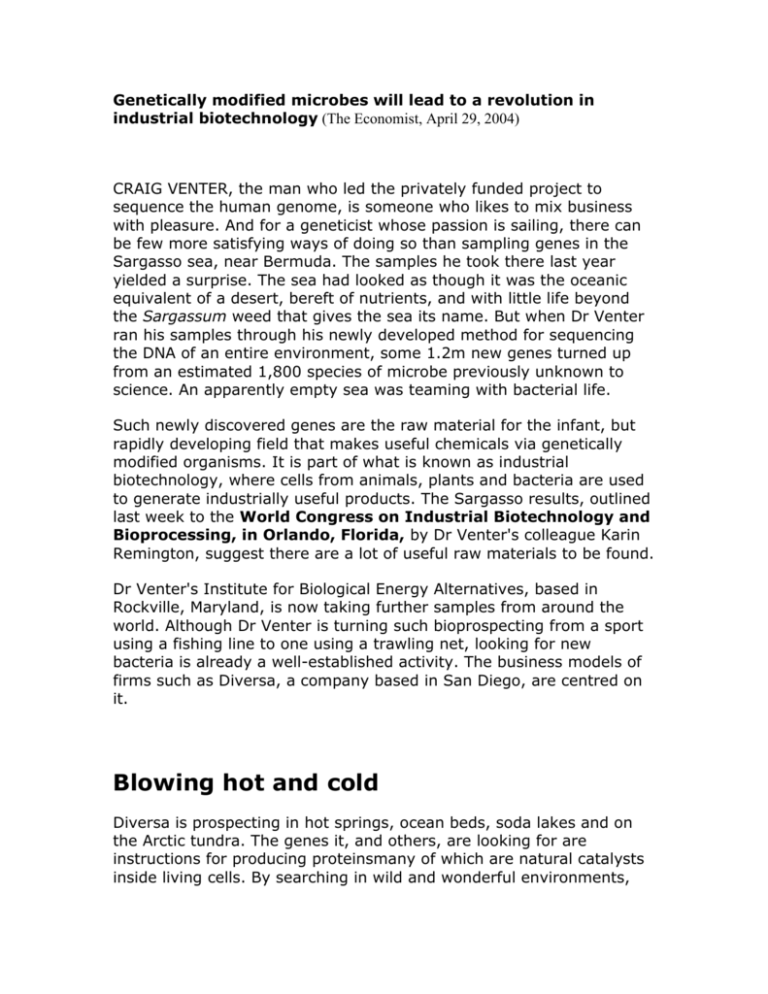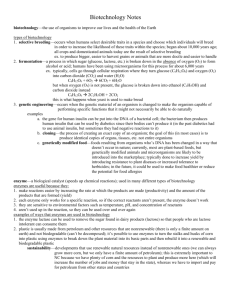
Genetically modified microbes will lead to a revolution in
industrial biotechnology (The Economist, April 29, 2004)
CRAIG VENTER, the man who led the privately funded project to
sequence the human genome, is someone who likes to mix business
with pleasure. And for a geneticist whose passion is sailing, there can
be few more satisfying ways of doing so than sampling genes in the
Sargasso sea, near Bermuda. The samples he took there last year
yielded a surprise. The sea had looked as though it was the oceanic
equivalent of a desert, bereft of nutrients, and with little life beyond
the Sargassum weed that gives the sea its name. But when Dr Venter
ran his samples through his newly developed method for sequencing
the DNA of an entire environment, some 1.2m new genes turned up
from an estimated 1,800 species of microbe previously unknown to
science. An apparently empty sea was teaming with bacterial life.
Such newly discovered genes are the raw material for the infant, but
rapidly developing field that makes useful chemicals via genetically
modified organisms. It is part of what is known as industrial
biotechnology, where cells from animals, plants and bacteria are used
to generate industrially useful products. The Sargasso results, outlined
last week to the World Congress on Industrial Biotechnology and
Bioprocessing, in Orlando, Florida, by Dr Venter's colleague Karin
Remington, suggest there are a lot of useful raw materials to be found.
Dr Venter's Institute for Biological Energy Alternatives, based in
Rockville, Maryland, is now taking further samples from around the
world. Although Dr Venter is turning such bioprospecting from a sport
using a fishing line to one using a trawling net, looking for new
bacteria is already a well-established activity. The business models of
firms such as Diversa, a company based in San Diego, are centred on
it.
Blowing hot and cold
Diversa is prospecting in hot springs, ocean beds, soda lakes and on
the Arctic tundra. The genes it, and others, are looking for are
instructions for producing proteinsmany of which are natural catalysts
inside living cells. By searching in wild and wonderful environments,
microbiologists hope to find new genes that might be of use to
investors and customers.
Many people now hope that this year's Orlando congress will
become an annual event. They see industrial biotechnology as the
wave of the futurea phenomenon that will eventually rock entire
economies. Whether this is the case or not, in the shorter term it does
seem likely that industrial biotechnology will shake up the chemical
industry. And it may provide a route to a future less dependent on
fossil fuels, and one that puts less climate-changing carbon dioxide
into the atmosphere.
Finding a gene, though, is only the first step towards a product of
commercial interest. Philippe Soucaille, chief scientific officer of a
company called Metabolic Explorer, based in Clermont-Ferrand,
France, told the meeting that his firm is working with a database of all
the biochemical pathways it can get its hands on and a computer
model of the metabolism of a bacterium called Escherichia coli. This is
the most popular organism for bacterial geneticists to experiment
upon, their equivalent to a laboratory rat.
Given a starting material and an end-product, Metabolic Explorer's
system will assemble the best set of pathways and then work out how
to fit them into E. coli, and say which existing E. coli pathways should
be deleted. It will also identify potential biochemical bottlenecks where
enzymes might need modifying to speed things up. Thus the company
can pick-and-mix biochemical pathways from different organisms and
put them together in a single bacterium, as a computer programmer
might assemble a piece of software from pre-written sub-routines.
Once the pathways have been selected, and the new enzymes
designed, it is just a question of adding the relevant genes to E. coli,
removing the genes for the undesired pathways, and seeing whether
the result lives up to expectations. Metabolic Explorer has already
done such work under contract for several other firms. Currently it is
using the process for its own benefit, to produce methionine, an
amino-acid animal-feed supplement with a market worth $1.4 billion a
year. Bio-Technical Resources, of Manitowoc, Wisconsin, has used a
similar technique to produce glucosamine, an amino-acid supplement
favoured by many people with arthritis.
Such sums, of course, are peanuts compared with the money to be
made outside the niche end of the chemicals market. But they
represent a bonanza to small biotechnology firms. And industrial
biotechnology looks set to make further inroads into the market for
boutique chemicals. Many other products have fallen, or look ready to
fall, to biotechnological processes that are cheaper than traditional
chemistry, have higher yields or produce a cleaner product. These
include other amino-acid supplements, vitamin supplements,
antibiotics, anti-influenza drugs, foundation creams for cosmetics and
even the solid rocket-fuel that is used in air-to-air missiles. According
to Jens Riese, of McKinsey, a consultancy, about 5% by value of the
world's chemical output is already biotech-based and this is expected
to rise to 10% over the next six years.
All this progress is largely invisible to the public. Indeed, given the
consternation about public reactions to agricultural biotech, there were
some misgivings among delegates as to what would happen when the
public realised what was going on. If the next phase of industrial
biotechnology works, the field's profile will grow considerably more
visible. The really serious money is to be made in bulk chemicals and
fuels.
Fantastic plastic
Genetic engineering can already deliver many traditional chemicalfeedstock molecules. Metabolic Explorer, for example, can turn glucose
into acrylate, a feedstock for the plastics industry. Cargill, a large
agricultural company that has been interested in biotechnology for
some time, is turning its attention to a glucose-derived substance
called 3-hydroxypropionic acid. This can be made with modified
microbes. Further microbes can then produce a dozen chemicals that
are precursors for plastics. John Frost of Michigan State University
(and the inventor of biotech rocket-fuel) has even worked out how to
use bacterial enzymes to make a form of Nylon. It all sounds
promising. But what biotechnology mostly cannot do yet is produce
either feedstock or finished product more cheaply than the
petrochemical industry.
There are a few well-trumpeted exceptions. Cargill-Dow, a jointventure between Cargill and Dow Chemicals, produces a cost-effective
polymer made from lactic acid that has, in turn, been made from
maize-derived glucose. Metabolix, a small firm based in Cambridge,
Massachusetts, has a suite of plastics called polyhydroxyalkanoates,
which are grown inside genetically engineered bacteria and that the
firm seems confident will be cost-competitive with at least some
existing specialist plastics. And DuPont, another big chemical
company, has Sorona, a plastic that is half biotech and half traditional.
But the breakthrough everybody is waiting for is a way of producing
glucose really cheaply. For glucose is to industrial biotech what crude
oil is to petrochemicals.
Once again, microbes are the key. The main source of industrial
glucose in North America is maize starch, which is relatively costly. But
most of the dry weight of a plant is composed of cellulose. Cellulose,
like starch, is a polymer of glucose. Unlike starch, though, it is tough.
But if it could be used to make glucose, much agricultural waste, such
as straw and the leftovers from maize farming, could be turned to
account. It can be broken down biologically, and the enzymes to do
such a job are found in many bacteria and fungi. The search is now on
for the best enzymes and ways of upgrading these into industrial
products.
Some significant progress has already been made. Novozymes is a
Danish company with a research laboratory in Davis, California that is
devoted to the question. And as Sarah Teter, one of the people in
charge of the project, explained, the firm is working on a mixture of
fungal enzymes that collaborate by attacking different parts of the
cellulose chain.
Novozyme's target chemical is actually ethanol. This is fermented from
glucose, and can be used as a substitute for petrol. The firm has
improved the process of fermenting cellulose into glucose, and then
glucose into ethanol, in ways that have reduced the cost ten-fold.
This still means that the enzyme processing for an American gallon of
cellulose-derived ethanol costs 50 cents. But Novozyme hopes to bring
that cost down another ten-fold over the next few years, to a point
where ethanol derived from cellulose might be cost-competitive with
petrol. And if ethanol can be made cheaply from cellulose, then so can
a lot of other bulk chemicals. One idea is to use special chips known as
DNA microarrays, which show what genes are active at a given
moment, to work out what other enzymes the fungi are making when
they digest cellulose. Chucking those enzymes into the mixture should
make a significant difference.
In an announcement whose timing was probably not coincidental, a
Canadian company called Iogen proudly proclaimed at the meeting
that its cellulose-ethanol plant in Ottawathe first such commercial
venture in the worldhad just opened for business. That plant is, in
part, the product of subsidies, so its true relevance remains to be
seen. But it is, as it were, a straw in the wind.
Copyright 2004 The Economist Newspaper and The Economist Group. All rights
reserved.
Erin Reese
Biotechnology Industry Organization (BIO)
1225 Eye Street, NW Suite 400
Washington, D.C. 20005-5958
Phone: (202) 962-9200 Fax: (202) 589-2548
www.bio.org
BIO represents more than 1,000 biotechnology companies, academic institutions,
state biotechnology centers and related organizations in all 50 U.S. states and 33
other nations. BIO members are involved in the research and development of
health-care, agricultural, industrial and environmental biotechnology products.








